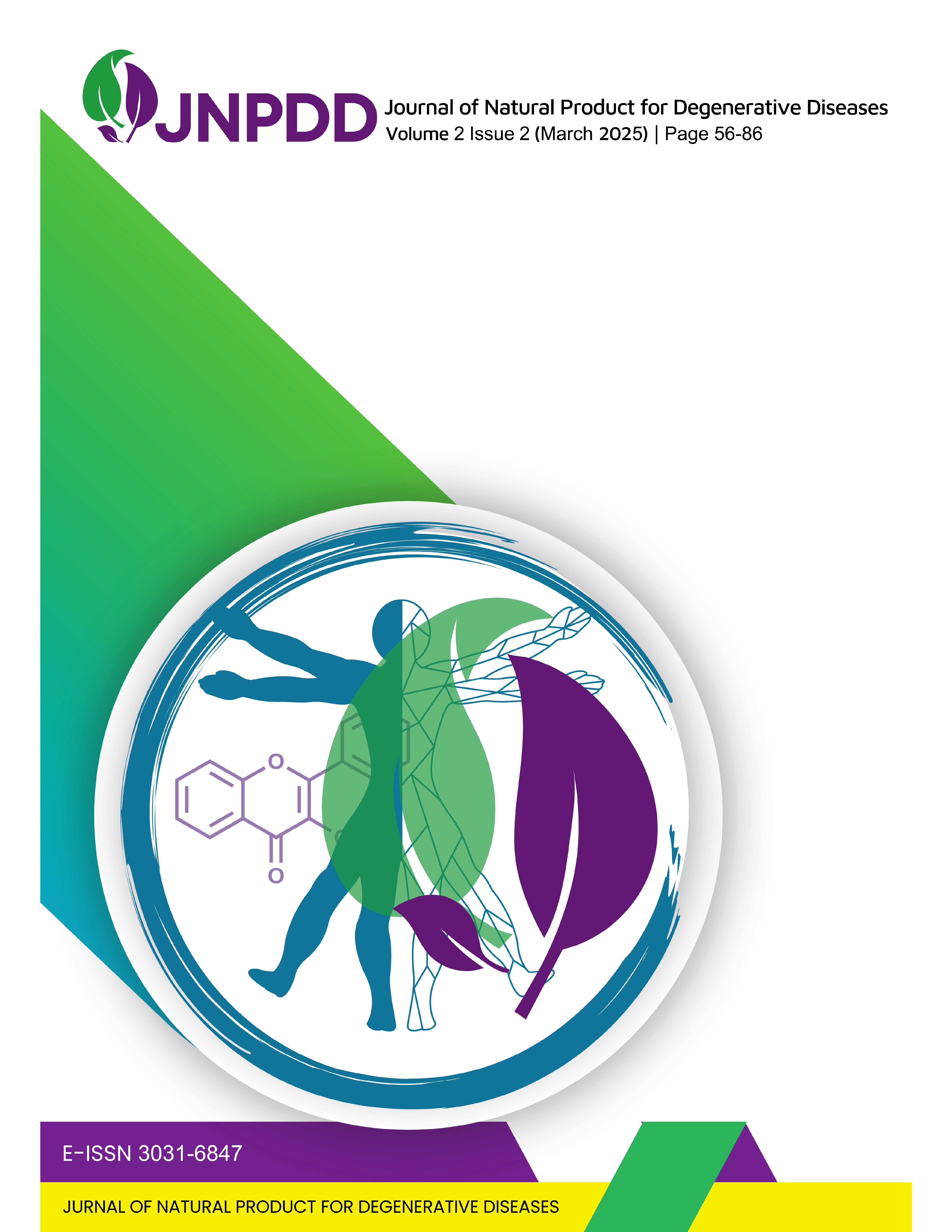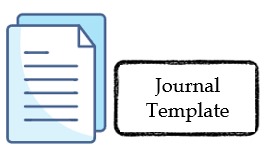Anti-inflammatory Activity of Glucomannan Resulting from β-mannanase Enzyme Hydrolysis in RAW 264.7 Cells
DOI:
https://doi.org/10.58511/jnpdd.v2i2.7797Keywords:
Antiinflammatory, Glucomannan, Hydrolysis, Macrophages, CytokinesAbstract
Glucomannan is a polysaccharide of the hemicellulose type, composed of glucose and mannose chains. It has the ability to form solutions that expand and thicken. The bioactivity of carbohydrates is influenced by the length of their saccharide chains. Hydrolysis can alter the structural dimensions of polysaccharides, including molecular weight, type, number, and position of substituent groups, which in turn impacts their biological activity. Various methods can modify carbohydrate structures to enhance their value, with degradation being one such method. Enzymatic degradation is particularly advantageous due to its high specificity, efficiency, and minimal side effects. Numerous studies have identified glucomannan as having immunomodulatory effects on macrophage cells. When stimulated with lipopolysaccharides, macrophages release various cytokines and inflammatory mediators, such as TNF-α, iNOS, and NO. This study explored the potential anti-inflammatory effects of glucomannan (GM) and its enzymatically hydrolyzed form (Enz-GM) on RAW 264.7 cells. The research involved degrading glucomannan using the β-mannanase enzyme, followed by in vitro testing of the degradation product (Enz-GM) for anti-inflammatory activity. This was achieved using an ELISA kit to measure the expression of IL-6, TNF-α, and iNOS. The results showed that Enz-GM at pH 9 (Mw 1.24 kDa) significantly reduced the pro-inflammatory cytokines IL-6 and iNOS (p ≤ 0.05) compared to GM, while TNF-α expression did not show a significant difference between Enz-GM and GM.
References
Shahbazi S, Bolhassani A. “Immunostimulants: Types and Functions”. J Med Microbiol Infect Dis. 2016;4(3):45–51.
Aryanti N, Abidin YK. Ekstraksi Glukomanan dari Porang Lokal. Metana. 2015;11(01).
Laksmitawati, Dian Ratih; Prilasari, Sharon Alia; Marwati U. “Nilai Indeks Glikemik dan Indeks Transit Usus Tepung porang (Amorphophallus muelleri Blume.) pada Mencit Putih”. J Farm Indones. 2017;9:317–23.
Zeng Y, Zhang J, Zhang Y, Men Y, Zhang B, Sun Y. “Prebiotic, Immunomodulating, and Antifatigue Effects of Konjac Oligosaccharide”. J Food Sci. 2018;0(0):1–8.
T, Akhtar; G, Ara; N, Ali; F, Ud Din Mufti; M IK. “Effects of dietary supplementation of mannan-oligosaccharide on virus shedding in avian influenza ( H 9 N 2 ) challenged broilers”. Iran J Vet Res. 2016;17(4):268–72.
Vi H, Ho T, Jovanovski E, Zurbau A, Mejia SB, Sievenpiper JL, et al. “A systematic review and meta-analysis of randomized controlled trials of the effect of konjac glucomannan , a viscous soluble fiber , on LDL cholesterol and the new lipid targets non-HDL cholesterol and apolipoprotein B”. AJCN. 2017;(C):1–9.
Faber TA, Dilger RN, Hopkins AC, Price NP, Jr GCF. “The effects of a galactoglucomannan oligosaccharide-arabinoxylan ( GGMO-AX ) complex in broiler chicks challenged with Eimeria acervulina 1”. Poult Sci. 2012;
Bauerová K, Paulovi E, Mihalová D, Š K, Poni S. “Study of new ways of supplementary and combinatory therapy of rheumatoid arthritis with immunomodulators . Glucomannan and Imunoglukán ® in adjuvant arthritis”. Toxicol Ind Health. 2009;329–35.
Veerasubramanian PK, Ponrasu T, Kannan R, Chakraborty S, Ramachandran B, Suguna L, et al. “An investigation of konjac glucomannan-keratin hydrogel scaffold loaded with Avena sativa extracts for diabetic wound healing [Internet]. Colloids and Surfaces B”: Biointerfaces. Elsevier B.V.; 2018. Available from: http://dx.doi.org/10.1016/j.colsurfb.2018.02.022
Nissa C, Madjid IJ. “Potensi glukomanan pada tepung porang sebagai agen anti-obesitas pada tikus dengan induksi diet tinggi lemak”. J Gizi Klin Indones. 2016;13(1):1–6.
Zhou Y, Qian C, Yang D, Tang C, Xu X, Liu EH, et al. “Purification, structural characterization and immunomodulatory effects of polysaccharides from amomum villosum lour. On raw 264.7 macrophages”. Molecules. 2021;26(9).
Cinelli MA, Do HT, Miley GP, Silverman RB. “Inducible nitric oxide synthase: Regulation, structure, and inhibition”. Med Res Rev. 2020;40(1):158–89.
Zhou Y, Qian C, Yang D, Tang C, Xu X, Liu EH, et al. “Purification, structural characterization and immunomodulatory effects of polysaccharides from amomum villosum lour. On raw 264.7 macrophages”. Molecules. 2021;26(9).
Li S, Xiong Q, Lai X, Li X, Wan M, Zhang J, et al. “Molecular Modification of Polysaccharides and Resulting Bioactivities”. Compr Rev Food Sci Food Saf. 2016;15(2):237–50.
Chen J, Liu D, Shi B, Wang H, Cheng Y, Zhang W. “Optimization of hydrolysis conditions for the production of glucomanno-oligosaccharides from konjac using β-mannanase by response surface methodology”. Carbohydr Polym [Internet]. 2013;93(1):81–8. Available from: http://dx.doi.org/10.1016/j.carbpol.2012.05.037
Ariestanti CA, Seechamnanturakit V, Harmayani E, Wichienchot S. Optimization on production of konjac oligo-glucomannan and their effect on the gut microbiota. Food Sci Nutr. 2019;7(2):788–96
Andiana M. Kultur Sel Baby Hamster Kidney (BHK) Menggunakan Media Dulbecco’s Modified Eagle Medium (DMEM). Biotropic J Trop Biol. 2017;1(1):1–8
Taciak B, Białasek M, Braniewska A, Sas Z, Sawicka P, Kiraga Ł, et al. Evaluation of phenotypic and functional stability of RAW 264.7 cell line through serial passages. PLoS One. 2018;13(6):1–13
Anggela A, Setyaningsih W, Wichienchot S, Harmayani E. Oligo-Glucomannan Production From Porang (Amorphophallus oncophyllus) Glucomannan by Enzymatic Hydrolisis Using β-Mannanase. Indones Food Nutr Prog. 2021;17(1):23.
Inkanuwat A, Sukaboon R, Reamtong O, Asawanonda P, Pattaratanakun A, Saisavoey T, et al. Nitric oxide synthesis inhibition and anti-inflammatory effect of polypeptide isolated from chicken feather meal in lipopolysaccharide-stimulated RAW 264.7 macrophages. Food Technol Biotechnol. 2019;57(2):200–11. https://doi.org/10.17113/ftb.57.02.19.5964
Syahidah HN, Hadisaputri YE. Review Artikel: Media Yang Digunakan Pada Kultur Sel. Farmaka [Internet]. 2016;14(3):27–36. Available from: http://jurnal.unpad.ac.id/farmaka/article/view/10615
Lendeckel U, Venz S, Wolke C. Macrophages: shapes and functions. ChemTexts [Internet]. 2022;8(2):1–12. Available from: https://doi.org/10.1007/s40828-022-00163-4
Zheng Q, Li W, Liang S, Zhang H, Yang H, Li M, et al. Effects of ultrasonic treatment on the molecular weight and anti-inflammatory activity of oxidized konjac glucomannan. CYTA - J Food [Internet]. 2019;17(1):1–10. Available from: https://doi.org/10.1080/19476337.2018.1541195
Affandi M, Wahyuli Z, Yuwono SS, Widjanarko SB. Anti-inflammatory activity of hydrolysed glucomannan from porang (Amorphophallus muelleri Blume) through inhibition response of nitric oxide production in lipopolisacharide (LPS)-activated RAW 264.7 macrophage cells. Advances in Food science, [Internet]. 2023; Available from: https://afssaae.ub.ac.id/index.php/afssaae/article/view/2117%0Ahttps://afssaae.ub.ac.id/index.php/afssaae/article/download/2117/167










